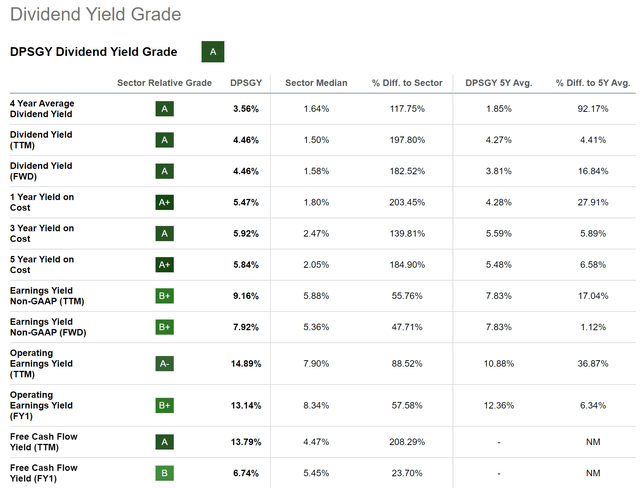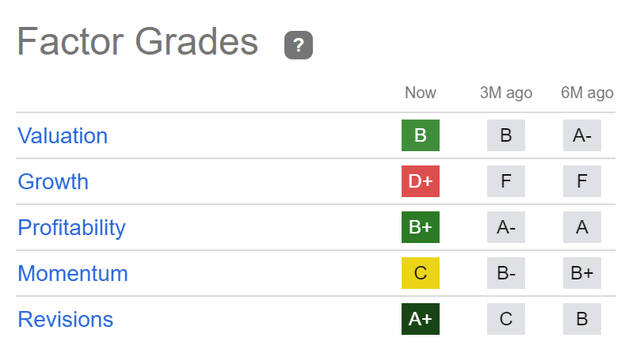Investment Thesis
Through the inclusion of companies that pay an attractive Dividend Yield and at the same time are able to provide your investment portfolio with Dividend Growth, you can benefit enormously from the extra income you generate via the dividend payments of the selected companies when investing over the long term.
Using this strategy that combines dividend income with dividend growth also helps you to understand that there is no need to sell positions of your investment portfolio in order to achieve capital gains: instead, you can benefit from annually increasing dividend payments of the high dividend yield and dividend growth companies that are part of your investment portfolio.
When finding companies that not only have an attractive Dividend Yield and show Dividend Growth, but also have an attractive Valuation, your benefits will be even greater. A low Valuation of a company you invest in helps to limit the downside risk of your investment, thus increasing the probability of achieving excellent investment results over the long term.
For these reasons, I have selected three companies from different sectors and industries that currently pay an attractive Dividend Yield, and, at the same time, have a relatively attractive Valuation. In addition to that, each of the selected picks has a 24M Beta Factor below 1, which implies that they can help you to reduce portfolio volatility and therefore reduce the risk level of your investment portfolio.
In order to make a pre-selection, the companies needed to fulfil the following requirements:
- Market Capitalization > $5B
- Dividend Yield [FWD] > 4%
- P/E [FWD] Ratio < 30
These are the companies that provide investors with a relatively high Dividend Yield and have a relatively low Valuation:
- Deutsche Post AG (OTCPK:DPSTF; OTCPK:DPSGY)
- The Kraft Heinz Company (KHC)
- Pfizer (PFE)
Deutsche Post AG
Deutsche Post AG operates globally as a mail and logistics company. The company has numerous competitive advantages that have helped it to build an economic moat over its opponents.
Through the company’s global network and worldwide operations, it has a strong global presence. Deutsche Post AG has further managed to establish a strong brand image and reputation, which is based on the fact that the company is seen as a trustworthy provider of mail and logistics services.
In addition, it can be highlighted that Deutsche Post AG has a broad and diversified product portfolio. This is underlined by the fact the company operates through the following five business segments:
- Express
- Global Forwarding, Freight
- Supply Chain
- eCommerce Solutions
- Post & Parcel Germany
The company’s Dividend Yield [FWD] currently lies at 4.46%, which stands 16.84% above its Average from the past 5 years, serving as a first indicator that it’s currently undervalued.
My opinion to currently rate the company as a buy is further underlined by its high Free Cash Flow Yield [TTM] of 13.79%. This high Free Cash Flow Yield suggests that the company is an excellent choice when considering risk and reward.
Below you can find the Seeking Alpha Dividend Yield Grade for Deutsche Post, which reinforces my theory that the company is an excellent option for dividend income investors.
Source: Seeking Alpha
The company’s attractive Dividend Growth Rate [CAGR] of 12.07% over the past 5 years and its relatively low Payout Ratio of only 48.26% further indicate that the German logistics company is not only an excellent choice for dividend income investors, but also for dividend growth investors.
I believe that Deutsche Post AG is an attractive pick in terms of Valuation: this is particularly based on its P/E [FWD] Ratio of 12.63, which lies 32.30% below the Sector Median, thus indicating that the company is undervalued at the time of writing.
The same is also confirmed when comparing it to companies outside of its peer group: Deutsche Post AG’s P/E [FWD] Ratio of 12.63 is significantly lower than the one of competitors such as FedEx (FDX) (P/E [FWD] Ratio of 15.84), UPS (UPS) (16.04) or Amazon (AMZN) (81.10), which is another indicator that the company’s Valuation is currently attractive.
The Kraft Heinz Company
The Kraft Heinz Company is a manufacturer and marketer of food and beverage products. The company markets its products under the following brand names: Kraft, Heinz, ABC, Ore-Ida, Oscar Mayer, Philadelphia, Velveeta, and Maxwell House.
Among the company’s competitive advantages are its broad product portfolio of strong brands, its economies of scale, its operational efficiency with low-cost management as well as its broad and international distribution network. These competitive advantages help to build an economic moat over smaller companies and prevent them from entering the business segment.
I believe that the company can be an attractive fit for dividend income investors that, in addition to a relatively high Dividend Yield, would like to reduce the volatility of their portfolio. This then helps you to reduce the investment portfolio’s risk level.
The Kraft Heinz Company’s Beta Factor of 0.27 is a clear indicator that you can significantly reduce the volatility by making the company part of your portfolio.
I consider the company’s Dividend Yield [FWD] of 4.37% to be attractive for dividend income investors, particularly because its Payout Ratio of 55.94% stands at a relatively low level, thus leaving room for future dividend enhancements in the years to come.
At the time of writing, The Kraft Heinz Company has a P/E [FWD] Ratio of 12.68. This Ratio lies 37.22% below the Sector Median and 51.19% below the company’s Average P/E [FWD] Ratio over the past 5 years. Both are indicators that The Kraft Heinz Company is currently undervalued, contributing to my current buy rating.
The company’s current P/E [FWD] Ratio of 12.68 lies significantly below the one of competitors such as General Mills (GIS) (P/E [FWD] Ratio of 18.96), Kellogg Company (K) (17.01), Danone (OTCQX:DANOY) (16.05) or Nestlé (OTCPK:NSRGY) (OTCPK:NSRGF) (20.08). This once again underlines that the company is undervalued at this moment in time.
Below you can find the Seeking Alpha Factor Grades, which further confirm that The Kraft Heinz Company is an appealing pick for investors while supporting my own buy rating for the company. The company is rated with an A+ for Revisions, a B+ for Profitability and a B for Valuation.
Source: Seeking Alpha
Pfizer
Pfizer develops, manufacturers and markets biopharmaceutical products on a global level. The company was founded in 1849 and disposes of a large number of competitive advantages that I will discuss in the following.
Pfizer’s broad and diversified product portfolio, its global distribution network, strong brand image (it is ranked 372 in the list of the most valuable brands in the world as according to Brand Finance), and its strong focus on Research & Development (Pfizer plans to spend between $12.4B and $13.4B in Research and Development in 2023) are some of the competitive advantages that can be named here.
It can further be highlighted that Pfizer currently pays a relatively high Dividend Yield [FWD] of 4.11%, which lies 162.63% above the Sector Median.
What makes the company even more attractive from an investors point of view is the fact that it has shown significant dividend growth within the past years (its Dividend Growth Rate [CAGR] over the past 10 years stands at 6.40%).
Additionally, it can be added that Pfizer’s Payout Ratio of 26.02% is at a relatively low level and indicates that the company should be able to continue providing shareholders with significant dividend growth in the years ahead.
Pfizer’s relatively high Free Cash Flow Yield [TTM] of 9.02% has also contributed significantly to my current buy rating for the company.
In addition to that, I would like to highlight that I believe Pfizer is currently undervalued. This is the case since the company’s current P/E [FWD] Ratio of 14.60 stands 46.67% below the Sector Median of 27.38. Furthermore, Pfizer’s current Price / Sales [FWD] Ratio of 3.31 lies 25.11% below the Sector Median, which I interpret as an additional indicator that the company is undervalued at this moment in time.
My opinion that Pfizer is currently undervalued is also supported when we compare the company’s P/E [FWD] Ratio to the one of its competitors: Pfizer’s P/E [FWD] Ratio of 14.60 is significantly lower than the P/E [FWD] Ratio of Novartis AG (NVS) (OTCPK:NVSEF) (19.94), Johnson & Johnson (JNJ) (21.50), AstraZeneca (OTCPK:AZNCF) (AZN) (25.85), or Merck & Co (MRK) (18.52).
Below you can find the Seeking Alpha Dividend Grades, which further confirm that Pfizer is an adequate pick for investors looking for both dividend income and dividend growth: the company receives an A+ for both Dividend Yield and Dividend Consistency and an A for Dividend Growth. For Dividend Safety, the company gets a B rating.
Source: Seeking Alpha
Risk Factors
I consider the risk level associated with an investment in one of these listed companies to be moderate when investing over the long term (and not speculating over the short term).
The fact that each of these three selected picks has a 24M Beta below 1, indicates that they can each contribute to reducing the volatility of your investment portfolio and therefore reduce its risk level: while Pfizer has a 24M Beta Factor of 0.57, Deutsche Post’s is 0.98, and The Kraft Heinz Company’s is 0.27.
In my opinion, it is important to include companies with a low Beta Factor in an investment portfolio because they contribute to reducing its volatility and risk level. This helps you to sleep better at night and to understand that you do not need to sell your stocks in times of a strong stock market decline. These stocks act as a defense play to protect your portfolio.
One of the main risk factors that I see for investors in Deutsche Post is the currency risk that comes attached to an investment (beside the strong competition the company is exposed to competing with opponents such as FedEx and UPS).
For The Kraft Heinz Company investors, I see its limited growth perspective as one of the main risk factors (the company has shown an Average Revenue Growth Rate of -0.60% over the past 5 years). However, due to the company’s low Valuation, the low growth expectations are already priced into the company’s stock price.
For Pfizer investors, I particularly see the company’s strong competition within the Pharmaceuticals Industry and Patent Expiries as risk factors for investors. However, I believe that the reward (in form of the compound annual rate of return) can be attractive for investors. This is also underlined through the company’s currently attractive Free Cash Flow Yield [TTM] of 9.02%.
From these 3 selected companies, which I have described in this article, I believe that Pfizer provides investors with the best chances in terms of risk and reward. Therefore, I would give Pfizer the highest proportion of the overall investment portfolio out of these three picks.
Conclusion
I believe that the three companies, which I have described in this article, provide investors with an attractive Dividend Yield. At the same time, they all currently have an attractive Valuation. I believe that the selected picks are undervalued at this moment in time, which underlines my buy rating for each of them.
Furthermore, it can be added that each of the selected picks can help you to reduce the volatility of your investment portfolio, which further contributes to decreasing its risk level.
In my opinion, including these companies with a low Beta Factor and an attractive Dividend Yield in your portfolio is important as it helps you to reduce the downside risk of your portfolio. Furthermore, it helps you in that you don’t need to continuously look at your account to see if your stocks are up or down.
Instead, you can sleep peacefully while benefitting from the dividend payments these companies offer you at the same time as helping to protect your investment portfolio.
Author’s Note: I would appreciate your opinion on this article! Which are currently your favorite high dividend yield companies that have a low Valuation?
Editor’s Note: This article discusses one or more securities that do not trade on a major U.S. exchange. Please be aware of the risks associated with these stocks.
Read the full article here













